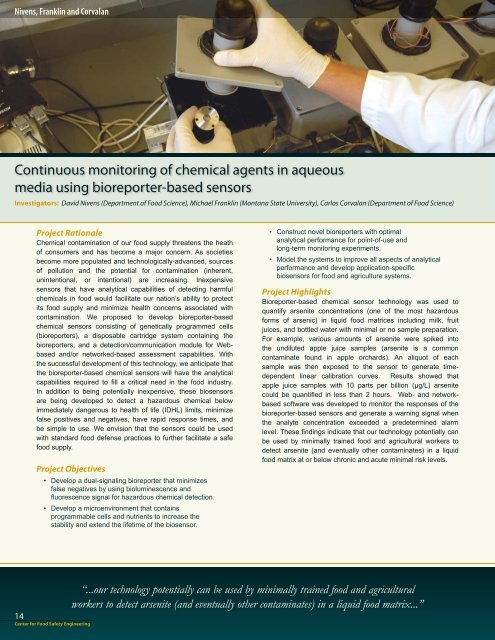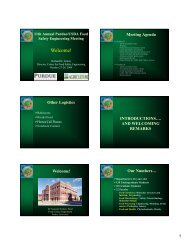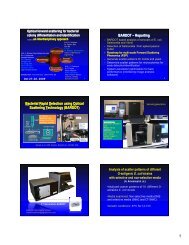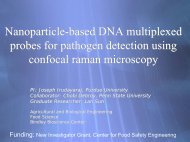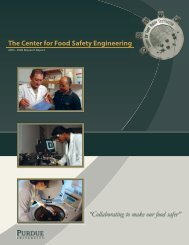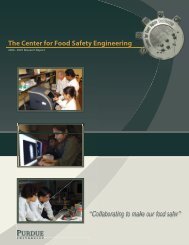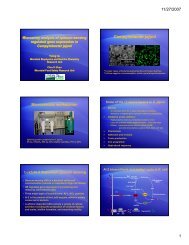Annual Report - Center for Food Safety Engineering - Purdue ...
Annual Report - Center for Food Safety Engineering - Purdue ...
Annual Report - Center for Food Safety Engineering - Purdue ...
You also want an ePaper? Increase the reach of your titles
YUMPU automatically turns print PDFs into web optimized ePapers that Google loves.
Nivens, Franklin and CorvalanContinuous monitoring of chemical agents in aqueousmedia using bioreporter-based sensorsInvestigators: David Nivens (Department of <strong>Food</strong> Science), Michael Franklin (Montana State University), Carlos Corvalan (Department of <strong>Food</strong> Science)Project RationaleChemical contamination of our food supply threatens the heathof consumers and has become a major concern. As societiesbecome more populated and technologically-advanced, sourcesof pollution and the potential <strong>for</strong> contamination (inherent,unintentional, or intentional) are increasing. Inexpensivesensors that have analytical capabilities of detecting harmfulchemicals in food would facilitate our nation’s ability to protectits food supply and minimize health concerns associated withcontamination. We proposed to develop bioreporter-basedchemical sensors consisting of genetically programmed cells(bioreporters), a disposable cartridge system containing thebioreporters, and a detection/communication module <strong>for</strong> Webbasedand/or networked-based assessment capabilities. Withthe successful development of this technology, we anticipate thatthe bioreporter-based chemical sensors will have the analyticalcapabilities required to fi ll a critical need in the food industry.In addition to being potentially inexpensive, these biosensorsare being developed to detect a hazardous chemical belowimmediately dangerous to health of life (IDHL) limits, minimizefalse positives and negatives, have rapid response times, andbe simple to use. We envision that the sensors could be usedwith standard food defense practices to further facilitate a safefood supply.Project Objectives• Develop a dual-signaling bioreporter that minimizesfalse negatives by using bioluminescence andfl uorescence signal <strong>for</strong> hazardous chemical detection.• Develop a microenvironment that containsprogrammable cells and nutrients to increase thestability and extend the lifetime of the biosensor.• Construct novel bioreporters with optimalanalytical per<strong>for</strong>mance <strong>for</strong> point-of-use andlong-term monitoring experiments.• Model the systems to improve all aspects of analyticalper<strong>for</strong>mance and develop application-specifi cbiosensors <strong>for</strong> food and agriculture systems.Project HighlightsBioreporter-based chemical sensor technology was used toquantify arsenite concentrations (one of the most hazardous<strong>for</strong>ms of arsenic) in liquid food matrices including milk, fruitjuices, and bottled water with minimal or no sample preparation.For example, various amounts of arsenite were spiked intothe undiluted apple juice samples (arsenite is a commoncontaminate found in apple orchards). An aliquot of eachsample was then exposed to the sensor to generate timedependentlinear calibration curves. Results showed thatapple juice samples with 10 parts per billion (μg/L) arsenitecould be quantifi ed in less than 2 hours. Web- and networkbasedsoftware was developed to monitor the responses of thebioreporter-based sensors and generate a warning signal whenthe analyte concentration exceeded a predetermined alarmlevel. These fi ndings indicate that our technology potentially canbe used by minimally trained food and agricultural workers todetect arsenite (and eventually other contaminates) in a liquidfood matrix at or below chronic and acute minimal risk levels.14<strong>Center</strong> <strong>for</strong> <strong>Food</strong> <strong>Safety</strong> <strong>Engineering</strong>“...our technology potentially can be used by minimally trained food and agriculturalworkers to detect arsenite (and eventually other contaminates) in a liquid food matrix...”


